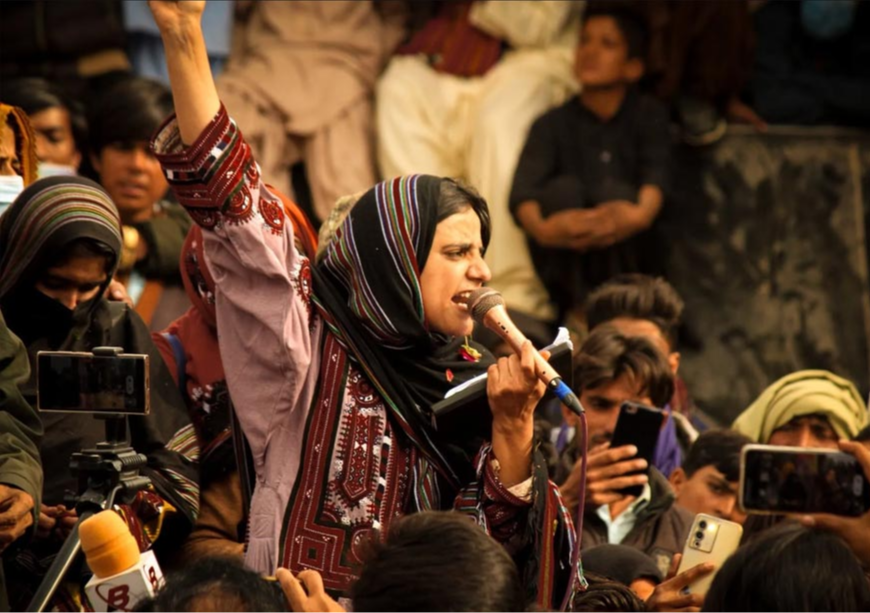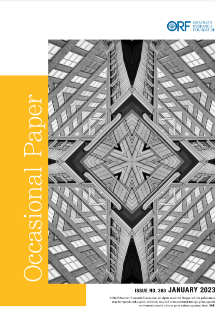
Source Image: [Courtesy of Mahrang Baloch]
On 11 April 2024, the ‘Movement against Baloch genocide’ entered its ‘fifth phase’, with protests erupting in 22 cities across Balochistan. Led by families demanding the return of their loved ones who have been victims of enforced disappearance, the movement seeks to address the long-standing humanitarian crisis in the region.
Fuelled by grief and outrage over the death of Balaach Mola Bakhsh at the hands of the Counter-Terrorism Department (CTD) in an allegedly staged encounter, the movement evolved from an atomistic struggle for justice into a broader campaign against enforced disappearances, police brutality, extrajudicial killings, labelled as the ‘Kill and Dump policy’. While protests have long been a feature of life in Balochistan, the movement distinguishes itself through its peaceful approach and the prominent role of women. Initiated in December 2023 by human rights activist, Dr. Mahrang Baloch from the Baloch Yakjehti Committee (BYC), the movement’s defining element is the ‘March Beyond Silence’. This peaceful, women-led long march from Turbat to Islamabad holds great significance in Balochistan's history, divorcing itself from the conventional acts of rebellion and showcasing remarkable resilience in the face of state-sponsored brutality.
Balochistan in turmoil: A multifaceted crisis and the China factor
The longstanding nationalist movement in Balochistan, stems from feelings of ethnic marginalisation and a perceived sense of underdevelopment. Despite abundant natural wealth (gold, gas, uranium) and a critical geostrategic location acting as a crucial choke point and trade route between the Middle East, Central Asia, and South Asia, the province remains the country’s poorest.
Demographic change owing to the influx of foreigners and injudicious resource use leading to ecocide and loss of their primary livelihood—fishing—exposed the façade of development promised to the locals.
Chinese inroads with the massive China-Pakistan Economic Corridor (CPEC) in Gwadar, Balochistan’s deep-sea port, vowing ‘development with Chinese characteristics’, has ironically backfired. Demographic change owing to the influx of foreigners and injudicious resource use leading to ecocide and loss of their primary livelihood—fishing—exposed the façade of development promised to the locals. They also report minimal trickle-down benefits from the mega–projects, with 91 percent of revenue from the US$62 billion CPEC reportedly going to China. Similarly, the Saindak Copper-Gold Project allocates a meagre 5-6 percent revenue for the Baloch provincial government. This economic alienation compels locals to demand enhanced political autonomy while harbouring anti-Chinese sentiments, thus adding another layer of complexity to the Baloch insurgency.
The state apathy continues
The Pakistan’s government's nefarious ‘Kill and Dump’ policy employs brutal tactics to suppress dissent in Balochistan. State intelligence agencies orchestrate abductions of human rights activists and dissidents, subjecting them to torture and often extrajudicial killings. The discovery of mass graves serves as a grim testament to this systematic violence. These human rights violations have been the driving force behind the ‘March Beyond Silence’. However, once again, the state preferred its policy of silencing dissent through intimidation. Despite Islamabad High Court’s authorisation of the ‘march’, reaffirming the protestors’ right to peaceful assembly, it suffered a harsh crackdown. The state's heavy-handed attempt to baton charge, withhold utilities in freezing weather, and arrest and suspend government employees facilitating the ‘march’, shows its unwillingness to engage in dialogue.
The former caretaker Prime Minister, Anwaar-ul-Haq Kakar, in a press conference, equated the protestors with terrorists, labelling their supporters as terrorist sympathisers. This led to a digital smear campaign against the protest, with many local journalists who were sympathetic to the cause facing threats and arrests. The resulting self-censorship undermined the movement's goal of gaining national attention. Mainstream media also followed suit by neglecting coverage in line with a state-imposed blackout.
State intelligence agencies orchestrate abductions of human rights activists and dissidents, subjecting them to torture and often extrajudicial killings.
Historically, vast discrepancies between official data and reports on the ground have plagued the issue of missing persons. Human rights groups like the “Voice of Baloch Missing Persons” claim over 7,000 cases since 2004, while the government constituted—Commission of Inquiry on Enforced Disappearances (COIOED) acknowledges only about 2,750 active cases. This gap allows the government to downplay the gravity of the crisis and stall investigations. Thus, despite choosing Islamabad as the epicentre, the ‘march’ failed to evoke national sentiments due to a distorted narrative presented by the state agencies.
Women-led protests
Baloch society, predominantly rural and guided by parochial tribal codes, adheres to strong patriarchal norms. This translates into stark gender disparity, with only 26 percent of Baloch women having ever attended school, one of the lowest literacy rates globally. In rural areas, this drops to a mere 2 percent, depicting the severity of systemic inequality faced by Baloch women. Female workforce participation stands at 14 percent , lower than the national average of 21 percent and the province also has the highest rate of child marriages. Significantly, Pakistan ranks 145 out of 146 countries on the Gender Gap Index of 2022, with Balochistan being its worst-performing province in terms of gender gap.
The imagery of women marching with mugshots serves as a powerful declaration of defiance against the state oppression.
In a society marked by strict gender roles, where women are typically relegated to domestic spheres and their public presence is tethered to male companionship, the absence of a breadwinner signifies a vulnerable and uncertain future. This compels these women to step out onto the streets, leaving them with little choice but to seek visibility and voice their concerns. Thus, the sight of women leading this ‘march’ is significant, marking a departure from entrenched cultural norms restricting their autonomy. Their presence at the forefront of this movement is a watershed moment, challenging traditional expectations and asserting their right to visibility and activism. The imagery of women marching with mugshots serves as a powerful declaration of defiance against the state oppression.
The involvement of women in the movement extends beyond non-violent methods like the ‘March Beyond Silence’. The nature of the Baloch rebellion is gradually transforming in response to the state's aggression. In April 2022, a 35-year-old graduate and a mother of two, Shari Baloch, executed a suicide attack on Karachi University, particularly targeting Chinese investments. Similarly, in June 2023, Sumaiya Qalandrani Baloch acted as a suicide bomber in an attack on a Pakistani military convoy. Both incidents were claimed by the Baloch Liberation Army (BLA), designated as a terrorist organisation by the United States and the European Union, which declared it as “the beginning of the era of female fidayeen (self-sacrifice) in the national movement.”
The trend reflects a mutual convergence of goals, where militant groups are embracing social progressivism making space for the gender minorities to assume leadership and combat roles and subsequently females are defying their traditional roles to fight for the common cause. Organisations like the BLA are reporting significant volunteerism by women because of their open recruitment policy. Besides, student-led cadres akin to the Baloch Students Organization Azad (BSOA) are instrumental in facilitating access and rationalising violence, mobilising youth and the educated class towards extremism to seek retribution or recognition.
The state’s persistent indifference or aggression might inadvertently create fertile ground for the rise of female suicide bombers.
The emergence of women as symbols of resistance also presents a strategic advantage for the militant groups. Since women are less likely to be suspected of carrying explosives and their attire adds another layer of protection. The state’s persistent indifference or aggression might inadvertently create fertile ground for the rise of female suicide bombers. This scenario, reminiscent of the 'Black Widows' who terrorised Russia in the early 2000s, poses a heightened risk for female political workers and activists, who could be increasingly targeted by security forces.
The failed commitment of reconciliation
The government's harsh response to the “March Beyond Silence” casts serious doubt on possible reconciliation. The intimidation and harassment tactics employed have created a significant trust deficit, likely hindering any positive resolution and prolonging the peace process. This lack of good faith is further evidenced by the continued disregard for legislation. Despite a 2021 bill criminalising enforced disappearances, the National Assembly has failed to enforce it. Similarly, court orders holding the state accountable have been ignored, leaving human rights groups to shoulder the burden of protests. The Baloch Yakjehti Committee (BYC) argues that the government's repression in Islamabad has unintentionally united the Baloch community. It has also exposed the oppressive nature of state policies, which they believe perpetuate a ‘Baloch genocide’.
The intimidation and harassment tactics employed have created a significant trust deficit, likely hindering any positive resolution and prolonging the peace process.
With the movement evolving into a more urban, youth-driven, women-led and middle-class phenomenon, continued neglect by the government will only alienate the people more. A comprehensive plan addressing Baloch's economic and political aspirations is urgently needed to fill the void left by the ‘anticipated’ decrease of the protests. Without such, the Baloch movement is likely to persist, creating a deepening crisis for the Pakistani state.
Vaishali Jaipal is an intern with the Strategic Studies Programme at the Observer Research Foundation
The views expressed above belong to the author(s). ORF research and analyses now available on Telegram! Click here to access our curated content — blogs, longforms and interviews.




 PREV
PREV


